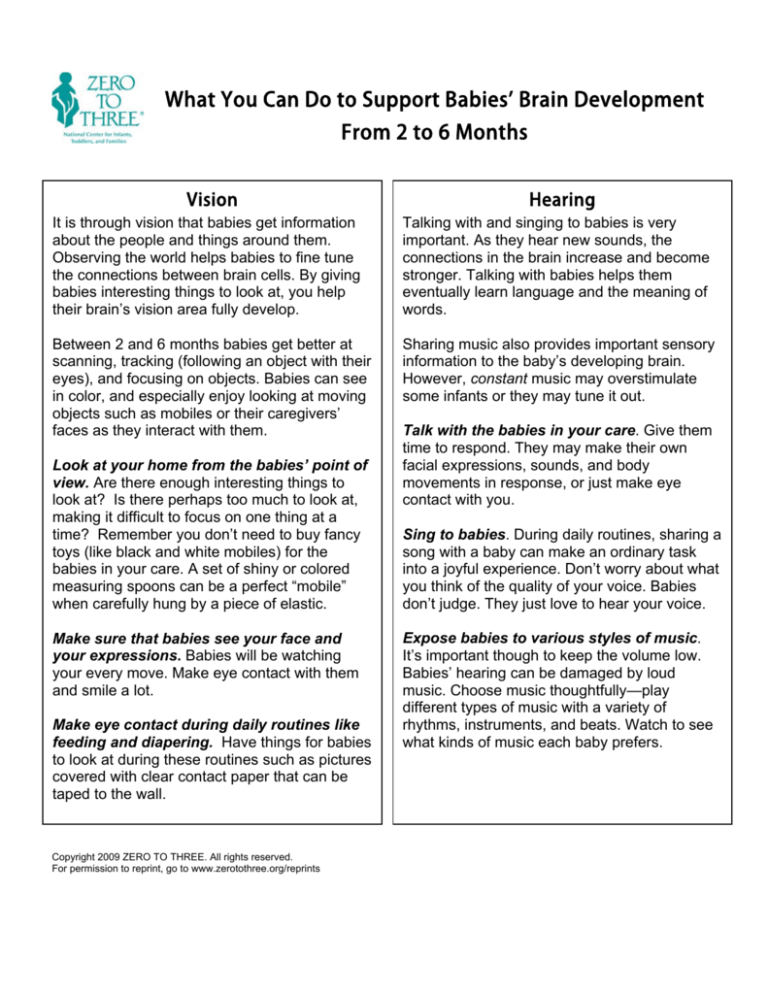
What You Can Do to Support Babies' Brain Development
From 2 to 6 Months
Vision
Hearing
It is through vision that babies get information
about the people and things around them.
Observing the world helps babies to fine tune
the connections between brain cells. By giving
babies interesting things to look at, you help
their brain’s vision area fully develop.
Talking with and singing to babies is very
important. As they hear new sounds, the
connections in the brain increase and become
stronger. Talking with babies helps them
eventually learn language and the meaning of
words.
Between 2 and 6 months babies get better at
scanning, tracking (following an object with their
eyes), and focusing on objects. Babies can see
in color, and especially enjoy looking at moving
objects such as mobiles or their caregivers’
faces as they interact with them.
Sharing music also provides important sensory
information to the baby’s developing brain.
However, constant music may overstimulate
some infants or they may tune it out.
Look at your home from the babies’ point of
view. Are there enough interesting things to
look at? Is there perhaps too much to look at,
making it difficult to focus on one thing at a
time? Remember you don’t need to buy fancy
toys (like black and white mobiles) for the
babies in your care. A set of shiny or colored
measuring spoons can be a perfect “mobile”
when carefully hung by a piece of elastic.
Make sure that babies see your face and
your expressions. Babies will be watching
your every move. Make eye contact with them
and smile a lot.
Make eye contact during daily routines like
feeding and diapering. Have things for babies
to look at during these routines such as pictures
covered with clear contact paper that can be
taped to the wall.
Copyright 2009 ZERO TO THREE. All rights reserved.
For permission to reprint, go to www.zerotothree.org/reprints
Talk with the babies in your care. Give them
time to respond. They may make their own
facial expressions, sounds, and body
movements in response, or just make eye
contact with you.
Sing to babies. During daily routines, sharing a
song with a baby can make an ordinary task
into a joyful experience. Don’t worry about what
you think of the quality of your voice. Babies
don’t judge. They just love to hear your voice.
Expose babies to various styles of music.
It’s important though to keep the volume low.
Babies’ hearing can be damaged by loud
music. Choose music thoughtfully—play
different types of music with a variety of
rhythms, instruments, and beats. Watch to see
what kinds of music each baby prefers.
What You Can Do to Support Babies' Brain Development
From 2 to 6 Months
Touch
Sleep
Touch is an important source of sensory
information during the 2–6 month age period. A
loving touch from parents and caregivers helps
build a sense of trust. Being held in a
caregiver’s arms lets babies know that they are
safe, secure, and loved.
As the brain develops and becomes more
mature, babies’ sleep becomes more regular
and predictable. When you see signs of
drowsiness such as droopy eyelids or a
decrease in activity and alertness, it’s a good
time to ease baby into sleep. Letting babies get
overtired can make falling asleep more difficult
for them.
It is also through touch that babies learn about
the properties of the objects in their world (such
as their texture and shape). This builds their
thinking skills.
Respond to babies’ signals that they need
comfort or interaction. They can show their
need by crying, fussing, reaching for you, or
gazing toward you to engage you.
Provide other “touch” experiences for the
baby. Even at this very early age, a baby needs
a variety of tactile experiences. Put him on
different surfaces such as towels, blankets with
different textures, or straw mats. Rub noses,
touch elbows, and pat knees. Let the babies
(safely) touch sticky surfaces, smooth surfaces,
bumpy surfaces like bubble wrap, and cool
surfaces.
Copyright 2009 ZERO TO THREE. All rights reserved.
For permission to reprint, go to www.zerotothree.org/reprints
Keep routines as consistent as possible.
Find out from families how their baby likes to
sleep. Try to provide a similar experience while
they are in your care.
Create an environment that encourages
sleep. Light, sound, and even temperature
may affect the brain’s sleep centers. So make
sure the nap area is darkened and quiet, and
keep the space at a moderate temperature.
Put babies to sleep on their backs. Research
shows that babies sleeping on their backs can
reduce the incidence of SIDS (sudden infant
death syndrome).
What You Can Do to Support Babies' Brain Development
From 2 to 6 Months
Movement
Play
Movement helps babies learn how to balance
and gain control over their bodies. This includes
moving side to side as when swaying, moving up
and down as when being bounced, and moving
back and forth as when walking in someone’s
arms.
Babies play by looking, listening, touching,
tasting, and moving. As babies play, important
sensory information is sent to their growing
brains. Playful interactions with parents and
caregivers are very important as babies learn that
their actions have an effect on both the people
and objects in their world. Play time with you
influences all areas of their development:
intellectual, physical, social, and emotional.
Allow babies to move and develop their
physical skills at their pace. Don’t force new
skills—for example, holding a baby up to stand
will not make her walk faster or better. Notice
how each baby’s physical skills are growing over
time, and give them opportunities to master new
skills when you see they are ready.
Put babies in areas on the floor where it is
safe to move around. Encourage rolling,
crawling, and walking by placing interesting toys
close by.
Do not use baby walkers. They can lead to an
increased risk of accidents. Avoid overusing
automatic baby swings as well. Too much time in
a swing means that babies are not being held,
touched, and played with by a caregiver. This
equipment also limits the time babies are able to
use their bodies to explore—such as rolling to get
closer to a desired person or interesting toy.
Copyright 2009 ZERO TO THREE. All rights reserved.
For permission to reprint, go to www.zerotothree.org/reprints
Keep babies safe. For young babies, play
usually means mouthing everything they can
place their hands on. Make sure toys are cleaned
regularly and that all choking hazards are
removed from the play area.
Show pleasure as you play with the babies.
Stick out your tongue and see if they will copy
you. Talk about what you are doing together as
you play, and use facial expressions. This
provides more information to the baby, which
increases her engagement and, therefore, her
brain power.
Use routines (changing a diaper, arriving/
departing, and waking from a nap) as chances
to pay individual attention to each baby.
Diaper changing can be a time to “play” with feet,
tickle toes and nose, talk about all his great body
parts, and wash each finger when you are
finished.
Provide safe and interesting objects to look at
and explore as babies grow. Provide toys with
a variety of colors, textures, and sizes (e.g.,
rattles, balls with different textures, soft objects),
and watch to see which each baby is most
interested in.
What You Can Do to Support Babies' Brain Development
From 2 to 6 Months
Crying
Crying is a primary way that babies communicate. It is important to
respond when babies cry as it lets them know: “I hear you. I am trying to figure
out what you want. Your needs and feelings are important.” Responding to
babies sensitively and consistently supports healthy brain development as it
calms them and reduces their stress. Research shows that high levels of
stress can negatively impact a young child’s growing brain.
Walk, rock, talk quietly, and sing to babies. Try rhythmic rocking motions.
Swaddle babies in a blanket or carry them in a sling or front pack if possible.
Use soft music, lullabies, or sounds that your babies find soothing. Help
babies find a safe object for sucking such as their fist or a pacifier. You can
also try walking a baby to a different room or outside, if possible.
Try to figure out what the cry is communicating. Look for patterns in the
babies’ cries to see if you can detect differences in cries for hunger, a soiled
diaper, fatigue, being overwhelmed, or, perhaps, bored. Are there certain
times of day or situations when a baby seems more distressed? Why might
that be? (Also keep in mind that sometimes young babies just cry and there
isn’t always a “reason.” Just being there to love and comfort the4m until the
spell passes is doing a lot.)
Talk to parents to share information and ideas. This kind of communication
helps everyone. You and parents can learn from each other by sharing your
observations about the baby—what you think different cries mean, patterns
you notice—and strategies that work to soothe the baby. The baby benefits
from this kind of collaboration among the people who care so much about him
as his basic needs get met, which supports his growing brain.
Copyright 2009 ZERO TO THREE. All rights reserved.
For permission to reprint, go to www.zerotothree.org/reprints







